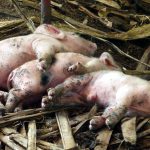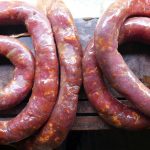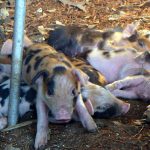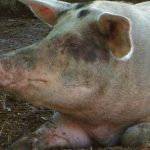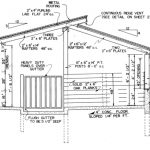The Figures in Loose-Farrowing Systems
According to studies, average pre-weaning mortality in loose farrowing systems commonly range from 20-33%. This is twice greater than that normally occurring in confinement farrowing crates. The major cause of piglet mortality in a loose-farrowing system is piglets being laid on by sows (often called ‘piglet crushing’). A survey of 40 producers using loose-farrowing systems in the midwestern United States indicated that average pre-weaning mortality of piglets was 26.4% and average litter size weaned was 6.7.
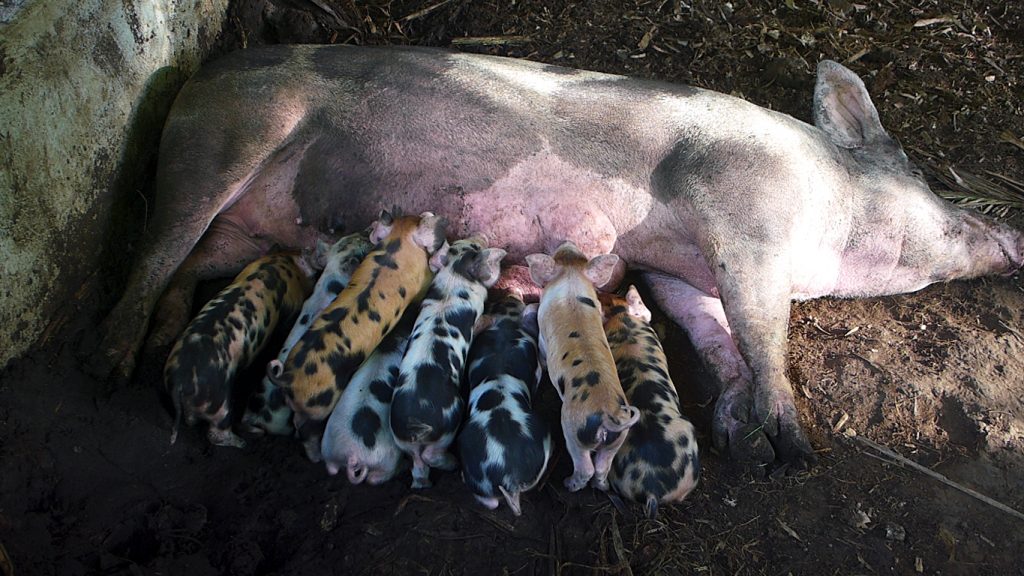
Our Figures in Loose-Farrowing Systems
Our sows farrow in a loose-farrowing system, a pen of about 22 square meters. The flooring is a mixture of soil, wood shavings and other dry and green organic matter. The pen has a small fenced area (creep space) and an escape hatch for piglets. The sow is given nesting materials (dry banana leaves) on the day of farrowing. Our current crushing rate – with minimum supervision – is 20%. Mortality due to disease is 0%. The sows, now 3 years and 4 months of age, are healthy and strong, and our piglet post-weaning mortality rate is 0%. The average litter size weaned at 45 days is 8 piglets.
Note: Minimum supervision means we do not intervene during farrowing. We provide nesting materials as soon as the sow asks for them and then we leave the sow alone, watching at a distance of 25 feet. We save piglets from crushing when we see or hear them. Because of minimum supervision during farrowing, we are often unable to determine stillbirths or whether piglets were live born and died through crushing. We have decided to include these mortalities in our crushing statistics.
Farrowing Crates and Farrowing Pens
The use of farrowing crates with supervision can reduce crushing mortalities down to 5-10%. However, piglets and sows raised in these conditions often have a higher incidence of disease and post-weaning mortality than their loose-farrowing counterparts. The use of farrowing crates are under scrutiny for welfare concerns and their use has been banned in some countries. Apart from pasture and loose-farrowing options, there are new designs of farrowing pens to address the concerns of producers. Below are two examples (first and second video).
The videos below show strip-grazing farrowing paddocks and indoor and outdoor systems in the UK.
How we try to reduce the incidence of crushing in a loose-farrowing system with minimum supervision
- Give sufficient nesting material. The nesting material of choice in the tropics is dry banana leaves. An abundant amount is necessary, between 15 to 20 large leaves or more depending on the farrowing space. The sow should have plenty of time to process the materials and build her nest. Our sows take 12 hours. She will shred the banana leaves. Sometimes, she is not able to do this well enough. Thus we give her banana leaves that are thoroughly dry so they are easy to shred. We may also cut the banana leaves along the length of the midrib so it is easier to shred and the tough midrib will not trap piglets.
- Keep the sow in good body condition. Do not overfeed the sow. Don’t make her overly fat. If the sow is too fat and heavy, she is not agile and flexible. She cannot avoid crushing her piglets and cannot get up quickly when a piglet squeals when crushed. Crushing is also common when the disparity in size of sow and newly born piglets is very large. Thus, research shows that crushing tend to be higher with older sows/higher parity. Our sows are nearly 4 years of age and we do our best to keep them fit and agile.
- Feed the sow on a regular schedule. We feed our lactating sows three times a day and we stick to this. Make sure the piglets are not in the path of the sow when you feed her, otherwise, she may step on her piglets in the excitement to eat.
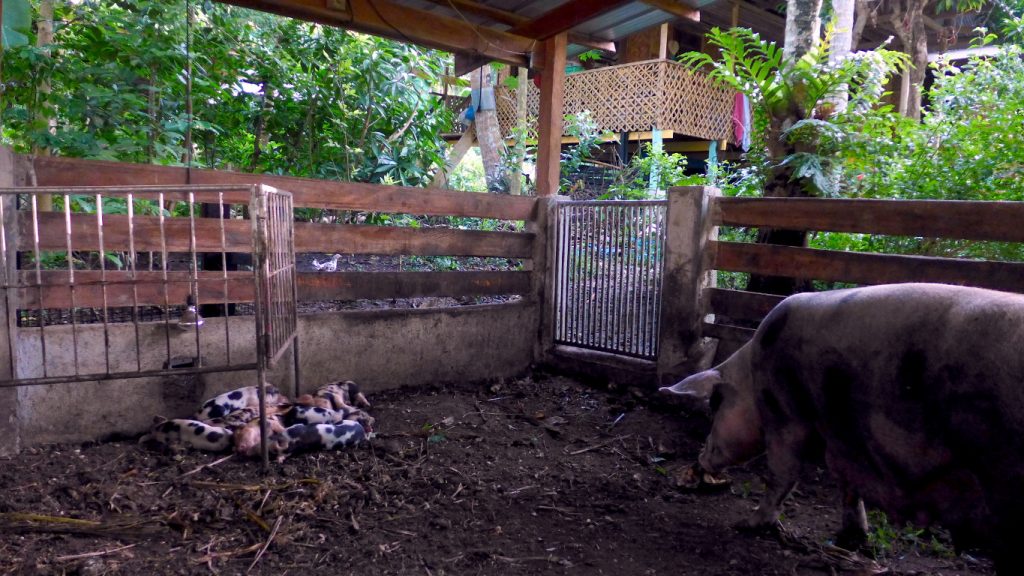
- Motivate sows to farrow next to the creep space. This isn’t easy and we’re trying to do this by working with the sow’s natural instincts and not working against it or by force. In a loose-farrowing system, we can’t dictate where the sow decides to build her nest and farrow. Our sows always build their nests away from the farrowing rail/creep space. The sows always want a location that is away from the gate, the feeding trough and the creep space. However, the sow often begins to nurse her piglets away from the nest 24 hours partuition. This is the time when we try to get her to nurse her piglets next to the farrowing rail/creep space. We do this by putting forage material for her to eat near the farrowing rail/creep space and by dripping water over her neck to cool her down in this location. Often, she will favour nursing at a location where she feels comfortable. When it gets too warm in one location, she will move to another.
- Provide heating in the creep space for piglets. Piglets seem to avoid bright lights so a bright heating lamp may not be suitable. We have tried incandescent lamps which are not suitable. We currently have infrared lamps which are still too bright. Perhaps a green coloured infrared lamp would be suitable. In a study, piglets are supposedly attracted by green colour. Use heating lamps only when temperatures are low (below 25°C) and only in the first few days to a week of farrowing. We notice that when temperatures go down to 22°C, the piglets will use the heated creep space even with the bright infrared lamp.
- Entice piglets to use the creep space. Piglets prefer to sleep in random places and they won’t even start sleeping in the creep space until they are 7 days old. We would really prefer if they used the creep space from Day 1 and avoid lying next to the mother. To get this to happen, we will need to motivate the sow to build her nest next to the creep space. In the video below, Sow Number 3 built her nest about 5 feet behind the creep space, in the corner of the pen. She has always considered this space a safe space for farrowing. We tried to entice piglets to the creep space by putting materials from the nest into the creep space. This did not work very well at all. We tried to entice the piglets by putting soil and grass in the creep space which seemed to have better results because piglets love exploring and eating soil.
- Reduce heat stress. Sow housing should be well ventilated and protected from long periods of sunlight. We have switched from dry to wet feeding to see how that may reduce heat stress. We also plan to install an electric fan in the farrowing pen, which may be directed to a cool space near the farrowing rail/creep space to entice the sow to nurse her piglets in that location. ‘Impact of Smallholder Management Strategies on Sow and Piglet Condition’ is an interesting doctoral thesis that shows the importance of some low-investment strategies for improving sow and piglet health and welfare in a tropical setting.
- Try to schedule farrowing in cooler months. In lowland locations in the Philippines, this would be in temperatures of 24-29°C. This is fine for sows and not overly cold for piglets. Sows have greater difficulty during the hot summer months and crushing rates are highest during these months.
- Establish a positive relationship with the sow, so the sow will not be stressed or threatened when she sees you. Avoid noise, sudden movements, distress. Talk gently, don’t shout. Never hit or hurt a sow.
- Treat MMA (mastatis, metritis, agalactia) ASAP. Check for mastitis which may be a reason why a sow would not nurse her piglets and easily get hurt by suckling. If mastitis is not present or cannot be treated within a few hours, grind or clip piglets’ teeth if necessary, for example, when the sow growls and refuses to nurse her piglets. The procedure must be done by an experienced animal technician. It must be done quickly and expertly. It must be done with no or very little piglet squealing. Collect the piglets and clip/grind their teeth away from the sow. Or you can let the sow out of the farrowing pen and process the piglets while she is away. In a loose-farrowing system, no other mutilation should be done – no tail cutting, ear notching or castration.
- Rest and relaxation for sow, exercise for piglets. Give the sow some control over the nursing schedule so she doesn’t get irritated by piglets squealing for milk. We try to do this by letting the piglets out of the farrowing pen through an escape hatch. The piglets spend time playing and rooting in the garden outside the pen while the sow rests undisturbed. When she wants to nurse her piglets she calls them. Although this doesn’t happen most of the time, it does help to relax and calm a sow when she can rest away from her piglets. In the above video, the piglets go out into the garden while their mother relaxes in the farrowing pen.In the video below, Sow Number 3 plays in her pen while her piglets are out in the garden. Number 3 is 3 years and 4 months old and yet she likes to play. She plays like this even when the piglets are in the pen, scaring the piglets, but she tries her best not to trample on the piglets.
- Understand the personality of your sow. All sows are different. Don’t blame a sow for crushing incidents. Instead, try and understand why crushing happens.
- If you witness a crushing incident: Wait for a few seconds to allow the sow to hear the squeal of her piglet and get up. This is an important process that will train the sow to heed the squeals of her piglets. This also trains the piglets to avoid the sow when she is about to lie down, thus sow and piglets learn to coordinate their movements. If the sow doesn’t get up in 10-20 seconds, you may approach her gently and entice her to get up. You can call her or ask her to have some food or water, forage etc. When the sow gets up, the piglet can escape. If the piglet doesn’t move, it may be suffocating. You can revive a piglet that isn’t breathing by holding it upside down and shaking it in a downward direction and giving it several slaps on the back. Put a finger in the piglet’s mouth to clear the airway and induce breathing. Massage its chest to get it to breath. Some studies have shown that piglets crushed for several minutes can still be revived. We have revived a couple of piglets in this manner. The video below shows two piglets that survived crushing. One piglet has a limp but this became better after several days.
Breeding for Good Maternal Instincts and Understanding The Sow
Domestic sows for commercial production have been selectively bred to be prolific. While wild and native sows have a litter of only 3-6 piglets, their domestic counterparts give birth to 12-14 per litter.
In the meantime, to cope with increasing litter sizes, studies are being made on selective breeding for good maternal instincts and other mitigation strategies to address health and welfare issues.
If we had a choice, we would prefer that the sow produced a smaller litter of piglets with high birth weight and lower or no crushing incidents. This would probably be the sow’s choice too. We have also wondered if a sow deliberately crushed her piglets when she had too many. An interesting paper on this topic is ‘Maternal behaviour in pigs and its relation to piglet performance and survival’. Some of the interesting theories mentioned in the paper are the following:
Theory of Maternal Investment
Some sows are more responsive to the piglets’ scream than others (Hudson et al. 1991). The question is, what differs those sows from the others? Is there any explanation for this variation? The main opinion about crushing seems to be that sows crush piglets by mistake, and that some sows are more caring than others. Andersen et al. (2005) questioned this a bit by presenting their theory about reducing maternal investment. The point with reducing maternal investment is to be able to have more offspring in the future (Manning & Dawkins, 1998). Most of the fatal crushing occurred the two first days after parturition and this supports Andersen et al. (2005) theory because then the maternal investment is still on a low level. The sows that crushed piglets had generally larger litters and this also support this theory because a large litter means a larger investment (Andersen et al. 2005). If Andersen et al. (2005) theory is correct; how can killing piglets increase the sow’s fitness? Infanticide is present in various species and the causation seems to be species dependent. Female rabbits sometimes kill their young and eat them. Boyd (1985) suggest that this may be one way for the rabbits to adjust the balance of stored nutrients and litter size in relation to the capacity to obtain nutrients from the environment. But this seems not to be the case for pigs because Andersen et al. (2005) do not mention anything about sows eating their crushed piglets.
Trivers-Willard Hypothesis
There is also a theory on sex-biased parental investment called the Trivers-Willard hypothesis. It predicts that parents will bias their sex ratio toward sons when in good condition and toward daughters when in poor condition. That daughters are more benefiting than sons during poor conditions are explained by the notion that males in poor body condition, which can be a result of poor environment, seldom gets a chance to mate (Trivers & Willard, 1979). This theory is sometimes used to explain infanticide. In a study made on wild boars they counted and sex determined fetuses in the uterine of wild boar females killed by hunting and they saw some tendency to biased litters. Small litters contained more males and large litters more females (Servanty et al., 2007). So it seems that there is a relationship between sex-ratio and litter size already early in pregnancy. If sex-ratio can be shifted already before birth it would probably be more inexpensive than provide them with nutrients during the whole pregnancy, give birth to them and then crush them. The piglets’ sex is not noted in Andersen et al. (2005) study so it is unclear if they crushed one sex more than the other.
Nest Building Theory
In a restricted environment, sows are more active during farrowing than sows kept in semi-natural environment (Thodberg et al., 2002). It could be a result of the restricted environment. A restricted sow may become stressed prior to farrowing, and continue to be so during farrowing, because she cannot perform her natural behaviour and build a suitable nest. The findings by Thodberg et al. (1999), that sows were more active prior to farrowing and less active during farrowing when given access to nest material, supports this theory. In a semi-natural environment the sow can express her natural behaviour to a much larger extent so that she might be more satisfied compared with the sows kept indoors. She have unlimited access to different kinds of nesting material so she can build a satisfying nest. If the sow doesn’t get the ability to build a nest she is satisfied with, she might not stop nesting. This is because the later phase of the nesting behaviour is triggered by feedback and external stimuli (Jensen, 1993).
The Isolation Hypothesis
Sows indoors are often kept very close to other sows. Sows living under natural conditions leave the group when they are about to farrow (Jensen, 1989) and it is likely that this behaviour has been evolutionary favoured; that it has increased the sow’s fitness in some way. The hypothesis of why the sow leaves the group is that the isolation is necessary for the piglets and the sow to learn to recognize each other and to avoid cross suckling (Jensen, 1986). One thing that may have a negative impact on the piglets’ survival is that sows kept close to each other can hear vocalizations from the other sows’ piglets. This may habituate her to the sound and way make her less attentive and responsive to the sounds that really mean something: the sounds from her own piglets. It is important that the sow react to distress calls from the piglets, otherwise she might crush them. Crushings often have underlying causes and they are interlinked. The piglet can be weakened for some reason or even already dead when the sow lies down on it. So, the sow cannot be blamed alone but her behaviour can in some cases affect the outcome. If she rises up to a sitting or standing position she may be able to save the piglet because many piglets die of suffocation (Weary et al. 1996). Because there is a genetic correlation between response to piglet distress calls and piglet mortality (Grandinson et al., 2003) it would most likely be possible to affect this trait by genetic selection.
Proactive/Reactive Theory
Thodberg et al. (2002) studied maternal behaviour in sows and used animals that previously, at younger age, had been tested for behavioural reactivity. The authors suggest that the extreme sows in this test had similarities to proactive and reactive types described for rodents. These two types of coping styles differ both behaviourally and endocrinologically. In mice, proactive individuals show more active avoidance behaviour, nest-building, routine formation and less flexibility than reactive individuals. Proactive individuals get high levels of catecholamines in the blood when they are stressed, but the cortisol levels stays low. (Catecholamines cause general physiological changes that prepare the body for physical activity (fight-or-flight response); while Cortisol is one of the most widely used biomarkers to detect stress in pigs). For reactive, is it the other way around, they get high levels of cortisol and low levels of catecholamines (Koolhaas et al., 1999). Proactive and reactive coping styles have also been studied in pigs. A study by Janczak et al. (2003) could not confirm that there are different coping styles in pigs whereas Ruis et al. (2000) got results supporting that there is. Thodberg et al. (2002) found that individuals showing proactive behaviour in the behavioural reactivity tests were behaving with less flexibility when it came to nursing. The reactive individuals appeared to be more in control of the nursing behaviour. However, the authors also recorded other traits in this study that did not fit the proactive/reactive theory (Thodberg et al., 2002).
Continuing Research
And finally, here is a potential breakthrough in reducing piglet crushing incidents. 😉 In the video below, Sow Number 3 is nursing her piglets in a standing position. Sow Auntie Brownie does this as well. The piglets are 18 days old in this video. If only the sows would do this from Day 1. However, because she was feeling so relaxed by the suckling, Sow Number 3 fell over and nearly crushed her piglets! She got up quickly and continued nursing them, then proceeded to eat. 🙂
And the work continues….
If you have experience with sows and the reduction of crushing incidents in loose-farrowing or pasture systems, we would love to hear from you. Please share your experiences with us in a comment to this post. Thank you and happy farming!

